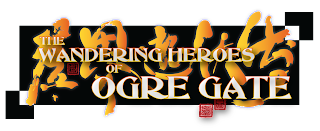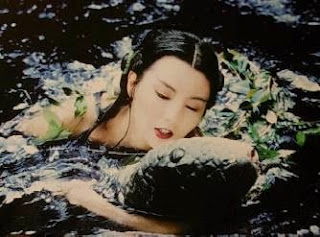
Characters:
Xue Lingsu (Purple Cavern Sect)
Xi Kang(Affiliated with Mr. Red Claw)
Zhi Zhu (No Sect)
Long Shu (Purple Cavern Sect)
Min (Purple Cavern Sect)
Rong (Tree-Dwelling Nun Sect)
The party re-united in Zun City. Long Shu, Lingsu and Min had just returned from the Tomb of the Timeless Master where they resolved things with Jia, the Snake Demon (she would become a member of Purple Cavern Sect and remain with Long Shu--who she believed was the reincarnation of her deceased husband, Shun). Kang, Rong and Zhi Zhu came to the city having removed Red Claw from power in Bei and stolen Lady White Blade's Wind Saber of Sunan.
While staying at the Hen-Shi Tea House, Long Shu was visited by Bronze Master who informed him that a member of The Golden Dragons (his own sect) had masqueraded as Lady Plum Blossom and killed Lady Tao (HERE). Bronze Master had the man, known as the Chameleon, beheaded and brought the body to Zun City to hand to Purple Cavern Sect. Bronze Master then formally apologized on his knees for the problems The Chameleon caused.
 |
| Illustration by Jackie Musto |
After the meeting with Bronze Master the party regrouped at the Tea House. Zhi Zhu went out on the roof to look around and saw a Flying Phantom (one of Mystic Sword Sect's elite disciples) peering at Long Shu's room from another roof 70 feet away. Getting the rest of the Party's attention they converged on the spy and Long Shu descended upon her with his I am the Arrow Technique. Spearing her through the shoulder, Long Shu demanded she talk. When Kang Threatened torture, she begged them not to make her betray Lady White Blade (she feared further maiming from her Sifu). Kang offered to take her into the Red Claw Gang as his student, giving her protection from Lady White Blade if she told them what she knew.
Nuan accepted and kowtowed three times, accepting him as her new Sifu. She then told the the party that Lady White Blade was planning an ambush outside town and was merely awaiting word from Nuan on their direction. She also informed them that Lady White Blade had sent a poisoned Phoenix Crown to Long Shu's room.
Long Shu quickly returned to the room and found Jia opening a box with a phoenix crown, told her it was dangerous and threw it out the window.
Before their departure the party discussed what to do with the Wind Saber of Sunan. They wanted to destroy it or place it somewhere safe. Lingsu went to Sun Mai temple to research and based on his information they decided it might be a good idea to find another immortal to give the sword to. Long Shu asked Jia where they might take it and she suggested the Iron Sky Maiden as a possibility (telling him she had hoped to find her so she could be made fully human). According to Jia the problem was finding her and knowing what gift to bring to earn her favor.
Bronze Master once again paid Long Shu a visit, informing him that Lady White Blade had recently married the head of Zhaoze Sect. He also told him he knew they had the sword and made the suggestion that a competition be held to see who should control the weapon (implying it was time for a new leader to unite the sects).
They used the information about the ambush to fool Lady White Blade, with Zhi Zhu masquerading as Nuan and sending a message that the party was leaving through the western gate (while they went through the eastern gate instead).
The Party made their way to Red Claw Pagoda because Kang told them Strange Phoenix had many books on Iron Sky Maiden. There Nuan was inducted into the organization as a formal member and as Kang's disciple. Strange Phoenix told them that Iron Sky Maiden was from the Kushen Basin and she believed there was a gate to her Realm in a strange rock formation in the middle of the desert. She was also a former member of Sun Mai Temple (the only woman ever to be inducted) and if they went to the Sun Mai Temple Headquarters in the south, the abbot might be able to give them guidance on gaining her favor. Before leaving they retrieved The Bear (Zhi Zhu's brother) with the intent of taking him with them to Sun Mai).
From the Red Claw Pagoda the group moved west to the mountain entrance of the Purple Caverns to speak with Lady Plum Blossom. Long Shu informed her about their dealings with Bronze Master (mentioning the competition). He also told her he intended to marry Jia, a snake demon. Lady Plum Blossom contemplated the problem of Jia's nature and ultimately decided that the couples' love and the sect's compassion mattered more than any concerns for reputation in the Jianghu. The marriage rites were performed in the The Shrine of Sunan and Bao and Jia and Long Shu were properly married.
After the wedding the party went to Sun Mai Temple. Along the way they contacted Jia's Zun Tribesmen (she is worshipped by members of the Sun Tribe) who informed her that Lady White Blade was on their trail (they also provided a guide through the wilderness and mountains). To evade Lady White Blade they detoured north and passed through Nature Loving Monk territory meeting with Begging Dog (the sect's leader). He drank with them and vowed to detain Lady White Blade should she pass through.
To get to Sun Mai they had to scale the south western mountains near Zhe Valley. While they initially lost their path, they eventually reached Sun Mai Temple. The Abbot accepted The Bear as an initiate and told the party that in life she was most attached to the town of Kwan Metta, a place far in the south, in Dhamma. She was its protector of the Pagoda of the Golden Mercies (a shrine to Hen-Shi in the center of the community). He believed if they brought a gift from the town to her, that might help them gain her favor. He also gave them a Jade Hen-Shi medallion, saying to present it to her if they earned her anger.
The party moved south and made good time but managed to get lost for a day. Kang asked Nuan to use her Flight of the Hawk technique to survey the area for Lady White Blade. Flying over the mountainside she spotted Lady White Blade's group waiting ahead at a nearby pass.
They tried to avoid the ambush, but their guide (who failed a Survival Roll) inadvertently led them into it. There they were confronted by Lady White Blade, Shang Long (leader of Zhaoze), The Venom of Zhaoze, Little Venom and Jade Butterfly.
 |
| Illustration by Michael Prescott |
Immediately Kang handed Zhi Zhu the sword and told her to run. She scrambled up the hills but Lady White Blade flew after her through the air causing an enormous melee to break out.
Lady White Blade attacked Zhi Zhu with Lady White Blade's Bursting Charge, but Zhi Zhu countered with Wall of Caltrops, creating a protective expanse of caltrops that pinned Lady White Blade in the air.
Rong dealt with the two Venoms, using Tree Bounding Stride to smash both of them. Nuan assisted with Slashing Blade (hitting both Venoms as well and killing Little Venom). The Venom of Zhaoze responded by using Naga Palm on Nuan (who started convulsing and developed a black hand print on her body. Rong unleashed Storming Daggers on The Venom of Zhaoze. Riddled with steel blades he dropped dead.
Kang used Somersault of the Drunken Monkey to attack against Shang Long, dazing him. Jia used her Whipping Strands to assist Kang. Kang struck Shang Long twice with Dog Bashing Stick while he was restrained. Jia then bit Shang Long, poisoning him with her venom.
Seeing that her side was quickly loosing, Jade Buttefly made no attack and was urged by Kang not to do so (he told her they had no grudge or will).
Zhi Zhu and Long Shu teamed up against Lady White Blade, using the opportunity presented by the Caltrop to attack. Long Shu speared her body with I am The Arrow. Zhi Zhu struck with the Wind Saber of Sunan, which paralyzed last White Blade. This allowed Long Shu to decapitate her.
Seeing he'd lost, knowing he was poisoned, Shang Long surrendered. Jia gave him the antidote to her venom and healed Nuan with Nine Divine Snakes Technique. They allowed Shang Long to leave and resumed their journey south.





















